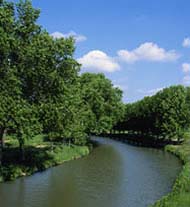Conservationists patch it up

Canals are assumed to help species to travel around the landscape. <br>Photodisc <br>
Urban wildlife may not use green corridors.
Green corridors do little to aid wildlife, say UK ecologists. Their discovery that isolated wild ground contains just as many plant species as do patches linked by continuous greenery casts doubt on current conservation priorities.
“The proportion of organisms that use [wildlife corridors] is exceedingly small,” says botanist Mark Hill of the Centre for Ecology and Hydrology in Monks Wood. Only vertebrates seem to benefit, he says.
“Resources would be much better spent managing habitat in the right way, rather than worrying about connections between patches,” adds conservation biologist Andrew Pullin, of the University of Birmingham.
Many environmental management plans, including the European Union’s Habitat’s Directive, promote wildlife corridors, such as hedges, railway embankments and canals. The assumption is that they help species to travel around the landscape, opening up habitat and reducing the risk of extinction.
“All other things being equal, they’re good, but all other things aren’t equal,” says Dave Dawson, biodiversity strategy manager with the Greater London Authority (GLA) and an expert on wildlife corridors.
The GLA’s conservation policy values corridors, but makes them a low priority. Enhancing or defending habitat is usually cheaper and more worthwhile, says Dawson. “If you’ve got limited resources, creating a corridor is the last thing you should put them into.”
Cross purposes
In 1998, the UK Natural Environment Research Council commissioned researchers, including Hill and Pullin, to look into the influence of corridors on wildlife in and around the city of Birmingham.
Early results suggest that many plants easily cross inhospitable territory, Hill told this week’s British Ecological Society’s Winter Meeting in Warwick, UK.
Open spaces on or near corridors have no more plant species than do more isolated counterparts, the researchers found. Most seeds are moved by building projects, cars and people. Birds and the wind are also important.
Green routes through the city can be habitat in their own right, and they can help to bring people into contact with wildlife, says Hill. “But they’re not a way that plants get about.”
Pullin, meanwhile, is comparing the DNA of butterflies from isolated and interconnected patches. Preliminary results suggest that butterflies can get to the two types of habitat with equal ease. “We frequently underestimate the dispersal capabilities of a lot of species,” he says.
Corridors of power
But ecologists may be reluctant to abandon corridors. They might benefit species other than those examined in this study, warns Chris Parry, principal ecologist with conservation charity the Wildlife Trust for Birmingham and the Black Country. “It’s common sense that habitats are better linked than isolated,” he says.
Plants and animals don’t see links in the same way as we do, counters Pullin. “They don’t look at a map and think, ’this is the best way to get from A to B’.”
Corridors fail some of the species that might be thought to need them most, agrees Dawson. Newts, for example, like to migrate in straight lines from their winter homes to their breeding ponds.
“The species that theoretically most need them tend to have fussy habitat requirements,” Dawson says. “The whole landscape needs to be amenable to wildlife.”
Media Contact
More Information:
http://www.nature.com/nsu/011220/011220-14.htmlAll latest news from the category: Ecology, The Environment and Conservation
This complex theme deals primarily with interactions between organisms and the environmental factors that impact them, but to a greater extent between individual inanimate environmental factors.
innovations-report offers informative reports and articles on topics such as climate protection, landscape conservation, ecological systems, wildlife and nature parks and ecosystem efficiency and balance.
Newest articles

Superradiant atoms could push the boundaries of how precisely time can be measured
Superradiant atoms can help us measure time more precisely than ever. In a new study, researchers from the University of Copenhagen present a new method for measuring the time interval,…

Ion thermoelectric conversion devices for near room temperature
The electrode sheet of the thermoelectric device consists of ionic hydrogel, which is sandwiched between the electrodes to form, and the Prussian blue on the electrode undergoes a redox reaction…

Zap Energy achieves 37-million-degree temperatures in a compact device
New publication reports record electron temperatures for a small-scale, sheared-flow-stabilized Z-pinch fusion device. In the nine decades since humans first produced fusion reactions, only a few fusion technologies have demonstrated…





















